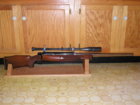Ned Ludd
Silver $$ Contributor
Thanks Ned, I’ll have to check out Quickload.
QuickLoad can be very useful and a good way to identify a starting point for load development. Most users find that some of the "preset" inputs such as case volume, need to be replaced with actual values in order to obtain better predictions. I generally use it with as many known inputs as I have (i.e. COAL, bullet OAL, true case volume, powder choice, etc.) to find the predicted upper limit (MAX pressure), and then look for possible accuracy nodes below that limit. I typically drop the charge weight another 2% or so for safety reasons, load up some rounds, then determine the average velocity for a known charge weight.
Once back at home, I use the average velocity data to "calibrate" the program for that specific rifle setup by inputting the actual temperature and adjusting the burn rate factor (Ba) until the predicted velocity exactly matches the measured velocity. Once that has been done, I find the predictions to be pretty accurate over a moderate range of charge weights. If you have to change the charge weight by a large amount, it may be necessary to re-adjust the burn rate factor (Ba) to get the predicted and actual velocities to match exactly. The program is largely set up to generate linear responses to changing parameters such as charge weight, but in reality, the response of velocity and pressure to changing charge weight is not always perfectly linear. QuickLoad is not a replacement for load development in any way, but I find it a very useful tool to expedite the process and analyze testing results.
https://www.neconos.com/quickload-ballistic-prediction-software/











